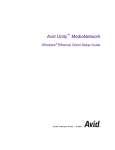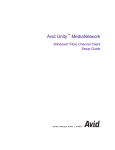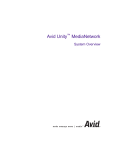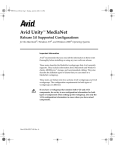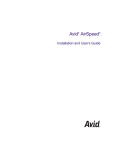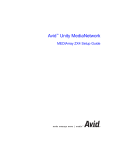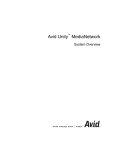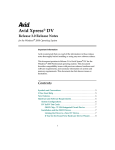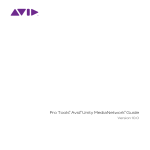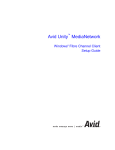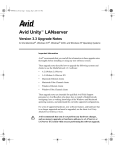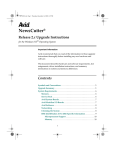Download AMX Rack Rail Kit MMS Servers Setup guide
Transcript
0525701A_BK.book Page i Tuesday, April 16, 2002 9:25 AM Trilligent Media Server Setup Guide 0525701A_BK.book Page ii Tuesday, April 16, 2002 9:25 AM Copyright and Disclaimer Product specifications are subject to change without notice and do not represent a commitment on the part of Avid Technology, Inc. The software described in this document is furnished under a license agreement. You can obtain a copy of that license by visiting Avid’s Web site at www.avid.com. The terms of that license are also available in the product in the same directory as the software. The software may not be reverse assembled and may be used or copied only in accordance with the terms of the license agreement. It is against the law to copy the software on any medium except as specifically allowed in the license agreement. Avid products or portions thereof are protected by one or more of the following United States patents: 4,746,994; 4,970,663; 5,045,940; 5,063,448; 5,077,604; 5,245,432; 5,267,351; 5,309,528; 5,325,200; 5,355,450; 5,396,594; 5,440,348; 5,452,378; 5,467,288; 5,513,375; 5,528,310; 5,557,423; 5,568,275; 5,577,190; 5,583,496; 5,584,006; 5,627,765; 5,634,020; 5,640,601; 5,644,364; 5,654,737; 5,701,404; 5,715,018; 5,719,570; 5,724,605; 5,726,717; 5,729,673; 5,731,819; 5,745,637; 5,752,029; 5,754,180; 5,754,851; 5,781,188; 5,799,150; 5,812,216; 5,828,678; 5,842,014; 5,852,435; 5,883,670; 5,889,532; 5,892,507; 5,905,841; 5,912,675; 5,929,836; 5,929,942; 5,930,445; 5,930,797; 5,946,445; 5,966,134; 5,977,982; 5,986,584; 5,987,501; 5,995,079; 5,995,115; 5,999,190; 5,999,406; 6,009,507; 6,011,562; 6,014,150; 6,016,152; 6,016,380; 6,018,337; 6,023,531; 6,023,703; 6,031,529; 6,035,367; 6,038,573; 6,052,508; 6,058,236; 6,061,758; 6,072,796; 6,084,569; 6,091,422; 6,091,778; 6,105,083; 6,118,444; 6,128,001; 6,128,681; 6,130,676; 6,134,379; 6,134,607; 6,137,919; 6,141,007; 6,141,691; 6,154,221; 6,157,929; 6,160,548; 6,161,115; 6,167,404; 6,174,206; 6,192,388; 6,198,477; 6,208,357; 6,211,869; 6,212,197; 6,215,485; 6,223,211; 6,226,005; 6,226,038; 6,229,576; 6,239,815; 6,249,280; 6,269,195; 6,271,829; 6,301,105; 6,310,621; 6,314,403; 6,317,142; 6,317,153; 6,317,515; D352,278; D372,478; D373,778; D392,267; D392,268; D392,269; D395,291; D396,853; D398,912. Additional U.S. and foreign patents pending. No part of this document may be reproduced or transmitted in any form or by any means, electronic or mechanical, including photocopying and recording, for any purpose without the express written permission of Avid Technology, Inc. Copyright © 2002 Avid Technology, Inc. and its licensors. All rights reserved. Printed in USA. The following disclaimer is required by Apple Computer, Inc. APPLE COMPUTER, INC. MAKES NO WARRANTIES WHATSOEVER, EITHER EXPRESS OR IMPLIED, REGARDING THIS PRODUCT, INCLUDING WARRANTIES WITH RESPECT TO ITS MERCHANTABILITY OR ITS FITNESS FOR ANY PARTICULAR PURPOSE. THE EXCLUSION OF IMPLIED WARRANTIES IS NOT PERMITTED BY SOME STATES. THE ABOVE EXCLUSION MAY NOT APPLY TO YOU. THIS WARRANTY PROVIDES YOU WITH SPECIFIC LEGAL RIGHTS. THERE MAY BE OTHER RIGHTS THAT YOU MAY HAVE WHICH VARY FROM STATE TO STATE. The following disclaimer is required by Sam Leffler and Silicon Graphics, Inc. for the use of their TIFF library: Copyright © 1988–1997 Sam Leffler Copyright © 1991–1997 Silicon Graphics, Inc. Permission to use, copy, modify, distribute, and sell this software [i.e., the TIFF library] and its documentation for any purpose is hereby granted without fee, provided that (i) the above copyright notices and this permission notice appear in all copies of the software and related documentation, and (ii) the names of Sam Leffler and Silicon Graphics may not be used in any advertising or publicity relating to the software without the specific, prior written permission of Sam Leffler and Silicon Graphics. THE SOFTWARE IS PROVIDED “AS-IS” AND WITHOUT WARRANTY OF ANY KIND, EXPRESS, IMPLIED OR OTHERWISE, INCLUDING WITHOUT LIMITATION, ANY WARRANTY OF MERCHANTABILITY OR FITNESS FOR A PARTICULAR PURPOSE. IN NO EVENT SHALL SAM LEFFLER OR SILICON GRAPHICS BE LIABLE FOR ANY SPECIAL, INCIDENTAL, INDIRECT OR CONSEQUENTIAL DAMAGES OF ANY KIND, OR ANY DAMAGES WHATSOEVER RESULTING FROM LOSS OF USE, DATA OR PROFITS, WHETHER OR NOT ADVISED OF THE POSSIBILITY OF DAMAGE, AND ON ANY THEORY OF LIABILITY, ARISING OUT OF OR IN CONNECTION WITH THE USE OR PERFORMANCE OF THIS SOFTWARE. 0525701A_BK.book Page iii Tuesday, April 16, 2002 9:25 AM The following disclaimer is required by the Independent JPEG Group: Portions of this software are based on work of the Independent JPEG Group. The following disclaimer is required by Paradigm Matrix: Portions of this software licensed from Paradigm Matrix. The following disclaimer is required by Ray Sauers Associates, Inc.: “Install-It” is licensed from Ray Sauers Associates, Inc. End-User is prohibited from taking any action to derive a source code equivalent of “Install-It,” including by reverse assembly or reverse compilation, Ray Sauers Associates, Inc. shall in no event be liable for any damages resulting from reseller’s failure to perform reseller’s obligation; or any damages arising from use or operation of reseller’s products or the software; or any other damages, including but not limited to, incidental, direct, indirect, special or consequential Damages including lost profits, or damages resulting from loss of use or inability to use reseller’s products or the software for any reason including copyright or patent infringement, or lost data, even if Ray Sauers Associates has been advised, knew or should have known of the possibility of such damages. The following disclaimer is required by Videomedia, Inc.: “Videomedia, Inc. makes no warranties whatsoever, either express or implied, regarding this product, including warranties with respect to its merchantability or its fitness for any particular purpose.” “This software contains V-LAN ver. 3.0 Command Protocols which communicate with V-LAN ver. 3.0 products developed by Videomedia, Inc. and V-LAN ver. 3.0 compatible products developed by third parties under license from Videomedia, Inc. Use of this software will allow “frame accurate” editing control of applicable videotape recorder decks, videodisc recorders/players and the like.” The following notice is required by Altura Software, Inc. for the use of its Mac2Win software and Sample Source Code: ©1993–1998 Altura Software, Inc. The following notice is required by Ultimatte Corporation: Certain real-time compositing capabilities are provided under a license of such technology from Ultimatte Corporation and are subject to copyright protection. Attn. Government User(s). Restricted Rights Legend U.S. GOVERNMENT RESTRICTED RIGHTS. This Software and its documentation are “commercial computer software” or “commercial computer software documentation.” In the event that such Software or documentation is acquired by or on behalf of a unit or agency of the U.S. Government, all rights with respect to this Software and documentation are subject to the terms of the License Agreement, pursuant to FAR §12.212(a) and/or DFARS §227.7202-1(a), as applicable. Trademarks AirPlay, AudioVision, Avid, Avid Xpress, CamCutter, Digidesign, FieldPak, Film Composer, HIIP, Image Independence, Marquee, Media Composer, Media Recorder, NewsCutter, OMF, OMF Interchange, Open Media Framework, Pro Tools, and Softimage are registered trademarks and 888 I/O, AirSPACE, AirSPACE HD, AniMatte, AudioSuite, AutoSync, AVIDdrive, AVIDdrive Towers, AvidNet, Avid Production Network, AvidProNet, AvidProNet.com, AVIDstripe, Avid Unity, AVX, DAE, D-Fi, D-fx, Digidesign Audio Engine, DINR, D-Verb, ExpertRender, FilmScribe, HyperSPACE, HyperSPACE HDCAM, Intraframe, iS9, iS18, iS23, iS36, Lo-Fi, Magic Mask, make manage move | media, Matador, Maxim, MCXpress, MEDIArray, MediaDock, MediaDock Shuttle, Media Fusion, Media Illusion, MediaLog, Media Reader, MediaShare, Meridien, NaturalMatch, NetReview, OMM, Open Media Management, ProEncode, QuietDrive, R&A, Recti-Fi, Review & Approval, rS9, rS18, Sci-Fi, Sound Designer II, SPACE, SPACEShift, Symphony, Trilligent, UnityRAID, Vari-Fi, Video Slave Driver, and VideoSPACE are trademarks of Avid Technology, Inc. iNEWS and Media Browse are trademarks of iNews, LLC. 0525701A_BK.book Page iv Tuesday, April 16, 2002 9:25 AM Microsoft and Windows are registered trademarks of Microsoft Corporation. Foundry is a registered trademark of, and FastIron and ServerIron are trademarks of Foundry Networks, Inc. All other trademarks contained herein are the property of their respective owners. Trilligent Media Server Setup Guide • Part 0130-05257-01 Rev. A • April 2002 0525701A_BK.book Page v Tuesday, April 16, 2002 9:25 AM Contents Using This Guide Who Should Use This Guide . . . . . . . . . . . . . . . . . . . . . . . . . . . . . . . . . . .ix About This Guide . . . . . . . . . . . . . . . . . . . . . . . . . . . . . . . . . . . . . . . . . . . . x Symbols and Conventions . . . . . . . . . . . . . . . . . . . . . . . . . . . . . . . . . . . . .xi If You Need Help . . . . . . . . . . . . . . . . . . . . . . . . . . . . . . . . . . . . . . . . . . . . xii If You Have Documentation Comments . . . . . . . . . . . . . . . . . . . . . . . . xii How to Order Documentation. . . . . . . . . . . . . . . . . . . . . . . . . . . . . . . . xiii Related Information. . . . . . . . . . . . . . . . . . . . . . . . . . . . . . . . . . . . . . . . . xiii Chapter 1 Installing a Media Server Before You Begin . . . . . . . . . . . . . . . . . . . . . . . . . . . . . . . . . . . . . . . . . . . 1-2 Installing the Media Servers. . . . . . . . . . . . . . . . . . . . . . . . . . . . . . . . . . 1-2 Installing Media Server Rack-Mount Rails . . . . . . . . . . . . . . . . . . 1-3 Connecting the Media Server Power Cord . . . . . . . . . . . . . . . . . . 1-3 Connecting the Media Server Cables . . . . . . . . . . . . . . . . . . . . . . . . . . 1-4 Connecting a Standard Keyboard, Monitor, and Mouse . . . . . . 1-4 Installing the Shelf. . . . . . . . . . . . . . . . . . . . . . . . . . . . . . . . . . . 1-4 Installing the Monitor . . . . . . . . . . . . . . . . . . . . . . . . . . . . . . . . 1-5 Connecting a Media Server to the KVM . . . . . . . . . . . . . . . . . . . . 1-5 Connecting a Media Server to the Fibre Channel Switch . . . . . . 1-6 Connecting Cables to the MEDIASwitch . . . . . . . . . . . . . . . . . . . 1-7 0525701A_BK.book Page vi Tuesday, April 16, 2002 9:25 AM vi Chapter 2 Configuring a Media Server Setting Up a Media Server . . . . . . . . . . . . . . . . . . . . . . . . . . . . . . . . . . . 2-2 Checking the Operating System is Properly Installed . . . . . . . . 2-2 Installing Windows 2000 Hotfixes . . . . . . . . . . . . . . . . . . . . . . . . 2-4 Setting the Date, Time, and Time Zone . . . . . . . . . . . . . . . . . . . . 2-4 Configuring the Network Properties . . . . . . . . . . . . . . . . . . . . . . 2-5 Setting Virtual Memory . . . . . . . . . . . . . . . . . . . . . . . . . . . . . . . . . 2-7 Configuring a Media Server . . . . . . . . . . . . . . . . . . . . . . . . . . . . . . . . . 2-8 Installing the Media Server Software . . . . . . . . . . . . . . . . . . . . . . 2-8 Mounting Workspaces on a Media Server. . . . . . . . . . . . . . . . . 2-10 Installing the Windows Media Services Software . . . . . . . . . . 2-11 Configuring Windows Media Technology Software . . . . . . . . 2-11 Installing Real Server Software . . . . . . . . . . . . . . . . . . . . . . . . . . 2-12 Configuring Real Server Software. . . . . . . . . . . . . . . . . . . . . . . . 2-12 Chapter 3 Configuring the Media Server as an FTP Server Configuring the Internet Information Server for FTP . . . . . . . . . . . . 3-1 Chapter 4 Installing and Configuring the Load-Balancing Network Switch Installing a Foundry Load-Balancing Switch . . . . . . . . . . . . . . . . . . . 4-2 Connecting a Media Server to the Switch . . . . . . . . . . . . . . . . . . . . . . 4-2 Configuring the MS Loopback Adapter . . . . . . . . . . . . . . . . . . . . . . . 4-3 Configuring the ServerIron Switch . . . . . . . . . . . . . . . . . . . . . . . . . . . 4-4 Advanced ServerIron Switch Configuration . . . . . . . . . . . . . . . . . . . 4-5 Chapter 5 Installing and Configuring a Routing Network Switch Installing a Foundry Routing Network Switch . . . . . . . . . . . . . . . . . 5-2 Connecting a Media Server to the Switch . . . . . . . . . . . . . . . . . . . . . . 5-2 Physical FastIron Switch Configuration . . . . . . . . . . . . . . . . . . . . . . . 5-3 Advanced FastIron Switch Configuration . . . . . . . . . . . . . . . . . . . . . 5-4 0525701A_BK.book Page vii Tuesday, April 16, 2002 9:25 AM vii Appendix A Media Server Specifications Dimensions and Weight . . . . . . . . . . . . . . . . . . . . . . . . . . . . . . . . . . . . . A-1 Environment . . . . . . . . . . . . . . . . . . . . . . . . . . . . . . . . . . . . . . . . . . . . . . . A-2 Electrical . . . . . . . . . . . . . . . . . . . . . . . . . . . . . . . . . . . . . . . . . . . . . . . . . . A-2 Power Cords . . . . . . . . . . . . . . . . . . . . . . . . . . . . . . . . . . . . . . . . . . . . . . . A-3 0525701A_BK.book Page viii Tuesday, April 16, 2002 9:25 AM viii Figures Figure 1-1 Attaching Optical Cable to the Fibre Channel Adapter Board . . . . . . . . . . . . . . . . . . . . . . . . . . . . . . . 1-6 Figure 1-2 Installing a GBIC . . . . . . . . . . . . . . . . . . . . . . . . . . . . . . . 1-7 Figure 1-3 MEDIASwitch Port Layout . . . . . . . . . . . . . . . . . . . . . . 1-8 Figure 1-4 Installing a SFP. . . . . . . . . . . . . . . . . . . . . . . . . . . . . . . . . 1-9 Figure 1-5 MEDIASwitch Port Layout . . . . . . . . . . . . . . . . . . . . . 1-10 Figure A-1 Receptacle (CEE-22). . . . . . . . . . . . . . . . . . . . . . . . . . . . A-3 Figure A-2 NEMA 5-15P Style Plug . . . . . . . . . . . . . . . . . . . . . . . . A-3 0525701A_BK.book Page ix Tuesday, April 16, 2002 9:25 AM Using This Guide Congratulations on your purchase of a Trilligent Media Server. The Media Server can be connected to a Trilligent Cluster or a MediaNet workgroup. You use the Media Server to stream video and audio files to your in-house network or to the Internet. n Your Media Server, Trilligent Cluster, or MediaNet workgroup might not contain all of the components or features described in the documentation. Avid’s documentation describes all components and features regardless of which configuration you purchased. Who Should Use This Guide This guide is intended for qualified Avid Field Support personnel or Avid Resellers who are installing, configuring, or maintaining a Media Server that is part of a Trilligent Cluster or a MediaNet workgroup. 0525701A_BK.book Page x Tuesday, April 16, 2002 9:25 AM x About This Guide This guide contains the information that you need to: • Install a Media Server. • Load and configure the Media Server client software. • Configure the Media Server as an FTP server. • Install and configure a load-balancing network switch. • Install and configure a network routing switch. This guide is organized as follows: Chapter 1, “Installing a Media Server,” describes how to install and connect a Media Server to a Trilligent Cluster or a MediaNet workgroup. Chapter 2, “Configuring a Media Server,” describes how to install and configure the Media Server software. Chapter 3, 'Configuring a Media Server as an FTP Server,” describes how to configure a Media Server for FTP, allowing files to be uploaded into specified folders. Chapter 4, “Installing and Configuring a Load-Balancing Network Switch,” describes how to install and configure a load-balancing network switch that you purchased from Avid. Chapter 5, “Installing and Configuring a Network Routing Switch,” describes how to install and configure a network routing switch that you purchased from Avid. Using This Guide 0525701A_BK.book Page xi Tuesday, April 16, 2002 9:25 AM xi Symbols and Conventions All of the material in this document applies to the Windows 2000 operating system. The Trilligent Media Server documentation uses the following special symbols and conventions: 1. Numbered lists, when the order of the items is important. a. • Bulleted lists, when the order of the items is unimportant. - t Alphabetical lists, when the order of secondary items is important. Indented dashed lists, when the order of secondary items is unimportant. One arrow indicates a single-step procedure. Multiple arrows in a list indicate that you perform one of the actions listed. Courier Bold font identifies text that you type. Look here in the margin for tips. In the margin, you will find tips that help you perform tasks more easily and efficiently. n A note provides important related information, reminders, recommendations, and strong suggestions. c A caution means that a specific action you take could cause harm to your computer or cause you to lose data. w A warning describes an action that could cause you physical harm. Follow the guidelines in this guide or on the unit itself when handling electrical equipment. Symbols and Conventions 0525701A_BK.book Page xii Tuesday, April 16, 2002 9:25 AM xii If You Need Help If you are having trouble using Trilligent Media Server, you should: 1. Retry the action, carefully following the instructions given for that task in this guide. 2. Check the documentation that came with your hardware for maintenance or hardware-related issues. 3. Check the release notes supplied with your Avid application for information on accessing the Avid Web site and the Avid Knowledge Center. 4. For support services, call Avid Customer Support: - Broadcast products — call 800-NEWS-DNG (639-7364). - Postproduction products — call 800-800-AVID (2843). - Trilligent products — call 800-800-AVID (2843). If You Have Documentation Comments Avid Technology continuously seeks to improve its documentation. We value your comments about this guide, the Help, the Online Publications CD-ROM, and other Avid-supplied documentation. Simply e-mail your documentation comments to Avid Technology at [email protected] Please include the title of the document, its part number, revision, and the specific section you are commenting on in all correspondence. Using This Guide 0525701A_BK.book Page xiii Tuesday, April 16, 2002 9:25 AM xiii How to Order Documentation To order additional copies of this documentation from within the United States, call Avid Telesales at 800-949-AVID (2843). If you are placing an order from outside the United States, contact your local Avid representative. Related Information The following documents provide more information about Trilligent Media Server: • Avid Unity MediaNet Site Preparation Guide • Avid Unity MediaNet File Manager Setup Guide • Avid Unity MediaNet Upgrade Notes • Avid Unity MediaNet System Overview • Avid Unity MediaNet Management Guide • Avid Unity MediaNet Troubleshooting Guide • Avid Unity MediaNet Macintosh Fibre Channel Client Setup Guide • Avid Unity MediaNet Macintosh Fibre Channel Client Quick Start Card • Avid Unity MediaNet Windows Fibre Channel Client Setup Guide • Avid Unity MediaNet Windows Fibre Channel Client Quick Start Card • Avid Unity MediaNet Macintosh Ethernet Client Setup Guide • Avid Unity MediaNet Macintosh Ethernet Client Quick Start Card • Avid Unity MediaNet Windows Ethernet Client Setup Guide • Avid Unity MediaNet Windows Ethernet Client Quick Start Card • Avid Unity MediaNet Release Notes How to Order Documentation 0525701A_BK.book Page xiv Tuesday, April 16, 2002 9:25 AM xiv Using This Guide 0525701A_BK.book Page 1 Tuesday, April 16, 2002 9:25 AM CHAPTER 1 Installing a Media Server This chapter describes how to install and connect a Media Servers to a Trilligent Cluster or a MediaNet workgroup. In a Trilligent Cluster you can connect up to 20 Media Servers to the MediaNet storage. In a MediaNet workgroup, you can connect up to two Media Servers to the MediaNet storage. Before you start the procedures in this chapter, you should have already installed the File Manager and storage for your Trilligent Cluster or MediaNet workgroup. 0525701A_BK.book Page 2 Tuesday, April 16, 2002 9:25 AM 1-2 Before You Begin Keep the shipping boxes that come with your Windows client. You might need to repackage and ship the components in the future. Before you begin to install the Media Server, do the following: • Unpack the Media Server kit. • Check the contents of the Media Server kit against the packing sticker on the outside of the shipping box to confirm you have received all the components. After you unpack your Media Server kit, make sure the kit contains: n • One Media Server with a 2-Gb optical Fibre Channel adapter board and an Ethernet adapter board. • One optical SFP. • One Media Server software kit containing: - The Avid Unity MediaNet Media Server Setup Guide, this manual - An Avid Unity MediaNet Windows Fibre Channel Client Quick Start Card - The Avid Unity MediaNet Release software CD-ROM Avid does not supply an optical cable with the Windows client kit. You must supply the cable separately. Installing the Media Servers A Media Server allows you to stream media files to your in-house network or to the Internet. It receives requests for the files to stream and works with the File Manager to locate the files on the MediaNet storage. Media Servers ship with a Fibre Channel adapter board and a gigabit network board already installed. They also have an autosensing power supply that sets the voltage correctly for either 120 volts or 240 volts. Installing a Media Server 0525701A_BK.book Page 3 Tuesday, April 16, 2002 9:25 AM 1-3 Installing Media Server Rack-Mount Rails When you are installing the Media Server rack-mount rails, follow the instructions supplied in the rail kit to install the rails while ensuring that: • The rails do not interfere with the power strips, power cords, or other cables at the back of the rack. • The bottom of the Media Server is at the bottom of a U-alignment space. • The rails allow the Media Server to slide completely into the rack. Connecting the Media Server Power Cord To connect the Media Server power cord: 1. Plug the power cord into the top power connector on the back of the Media Server. 2. Plug the power cord into the left power strip in the back of the rack. 3. If the Media Server has a second power supply, plug the power cord into the bottom power connector on the back of the Media Server. 4. Plug the power cord into the right power strip in the back of the rack. Installing the Media Servers 0525701A_BK.book Page 4 Tuesday, April 16, 2002 9:25 AM 1-4 Connecting the Media Server Cables You need to connect the Media Server to a keyboard, mouse, and monitor, or to a keyboard/video/mouse switch (KVM), the Fibre Channel switch, and your network. Do one of the following: t If you are connecting a standard keyboard, mouse and monitor to the Media Server, continue with “Connecting a Standard Keyboard, Monitor, and Mouse” on page 1-4. t If you are connecting a KVM to the Media Server, continue with “Connecting a Media Server to the KVM” on page 1-5. Connecting a Standard Keyboard, Monitor, and Mouse If you are using a standard keyboard, monitor, and mouse, you can install them on a desktop next to a rack or you can mount them on a shelf in the rack. Installing the Shelf If you are installing a shelf, follow the instructions supplied with the shelf to install it while ensuring that: Installing a Media Server • The shelf does not interfere with the power strips, power cords, or other cables at the back of the rack. • The shelf allows the monitor to slide completely into the rack. • You install the rails at the nearest U-alignment location. • The bottom of the shelf is at the bottom of a U-alignment space. 0525701A_BK.book Page 5 Tuesday, April 16, 2002 9:25 AM 1-5 Installing the Monitor To connect the Media Server to a monitor: 1. Set the monitor on the desktop or shelf. Route the power cord and cable to the back of the rack. 2. Plug the power cord into the back of the monitor. 3. Plug the power cord into the left power strip in the back of the rack. 4. Plug the keyboard cable into the keyboard port on the back of the Media Server. 5. Plug the mouse cable into the mouse port on the back of the Media Server. Connecting a Media Server to the KVM To connect the a Media Server to a KVM: 1. Locate a KVM cable in the kit. It has a 25-pin connector on one end, and a 9-pin connector, a keyboard connector and a mouse connector on the other end. 2. Attach the 25-pin connector to a free port on the back of the KVM. Secure the connector with the thumbscrews in the connector. 3. Attach the 9-pin connector to the video port on the back of the File Manager. Secure the connector with the thumbscrews in the connector. 4. Push the keyboard cable connector into the keyboard connector on the back of the File Manager. The keyboard connector is at the bottom-left of the connectors on the File Manager. 5. Push the mouse cable connector into the mouse connector on the back of the File Manager. The mouse connector is directly above the keyboard connector. Connecting the Media Server Cables 0525701A_BK.book Page 6 Tuesday, April 16, 2002 9:25 AM 1-6 Connecting a Media Server to the Fibre Channel Switch To connect a Media Server to the MEDIASwitch: 1. Locate the optical cable. Look for a cable with a dual plug on the end (see Figure 1-1). 2. Make sure the cable has an LC (small) optical connector to match the connector on the adapter board. If the connector is not the correct one, contact your optical cable installer to arrange for them to change the connector. 3. Remove the protective covers from the optical connector on the optical cable. 4. Remove the protective cover from the Fibre Channel adapter board in the Media Server. 5. Plug the optical cable connector into the adapter board. The connector and adapter board are keyed and only fit together one way. You should hear a click when the cable is properly seated (see Figure 1-1). LEDs Optical Fibre Channel adapter board Optical cable Optical connector Figure 1-1 Attaching Optical Cable to the Fibre Channel Adapter Board 6. Attach the other end of the optical cable to the MEDIASwitch as described in “Connecting Cables to the MEDIASwitch” on page 1-7. Installing a Media Server 0525701A_BK.book Page 7 Tuesday, April 16, 2002 9:25 AM 1-7 Connecting Cables to the MEDIASwitch The MEDIASwitch connects the Trilligent Cluster or MediaNet workgroup to several Media Servers. The switch allows the Media Servers to use the storage simultaneously. The switch prevents work interruptions by allowing other clients in the workgroup to continue working if one or more clients go offline. Avid supports two types of MEDIASwitches; 1-Gb MEDIASwitches and 2-Gb MEDIASwitches. The 1-Gb MEDIASwitch uses GBICs to connect the cables to the switch. The 2-Gb MEDIASwitch uses SFPs to connect the cables to the switch. Connecting to a 1-Gb MEDIASwitch To connect an optical cable to the 1-Gb MEDIASwitch: 1. Locate the GBIC in the Media Server kit. 2. Route the cable from the Media Server to the MEDIASwitch, if it has not already been installed. 3. Position the GBIC in front of a MEDIASwitch port (see Figure 1-2). Make sure the optical connector is facing away from the MEDIASwitch. Figure 1-2 Installing a GBIC Connecting the Media Server Cables 0525701A_BK.book Page 8 Tuesday, April 16, 2002 9:25 AM 1-8 n You can install the GBIC while the MEDIASwitch is turned on. 4. Slide the GBIC into the MEDIASwitch port. You should hear the retainer clips click when the GBIC is seated in the port. 5. Remove the protective covers from the optical connector on the optical cable. 6. Remove the protective cover from the GBIC in the MEDIASwitch. 7. Attach the connector on the cable into the GBIC for the Media Server (see Figure 1-3). Firmly push the plug on the cable into the connectors on the optical GBIC. MediaNet client ports MGMT Act/Col 100 7100 1 2 3 4 5 6 File Manager ports 7 RS232 8 Storage ports File Manager ports MediaNet client ports MGMT 1 2 3 4 5 6 7 8 9 10 11 12 13 14 15 16 7200 MediaNet client ports Figure 1-3 Act/Col 100 RS232 Storage ports MEDIASwitch Port Layout 8. Label the cable with the name or location of the Media Server to which it connects. Installing a Media Server 0525701A_BK.book Page 9 Tuesday, April 16, 2002 9:25 AM 1-9 Connecting to a 2-Gb MEDIASwitch To connect an optical cable to the 2-Gb MEDIASwitch: 1. Locate the SFP in the Media Server kit. 2. Route the cable from the Media Server to the MEDIASwitch, if it has not already been installed. 3. Position the SFP in front of a MEDIASwitch port (see Figure 1-4). Make sure the optical connector is facing away from the MEDIASwitch. 0 MT Act/C ol 10 MG 2 23 RS 8 7 6 5 4 3 2 1 Figure 1-4 n Installing a SFP You can install the SFP while the MEDIASwitch is turned on. 4. Slide the SFP into the MEDIASwitch port. You should hear a click when the SFP is seated in the port. 5. Remove the protective covers from the optical connector on the optical cable. 6. Remove the protective cover from the SFP in the MEDIASwitch. Connecting the Media Server Cables 0525701A_BK.book Page 10 Tuesday, April 16, 2002 9:25 AM 1-10 7. Attach the connector on the cable into the SFP for the Media Server (see Figure 1-5). Firmly push the plug on the cable into the connectors on the optical SFP. 8. Label the cable with the name or location of the Media Server to which it connects. File Manager ports 9100 Storage ports MGMT RS232 1 2 3 Act/Col 100 4 MediaNet client ports File Manager ports Storage ports MGMT 9200 RS232 1 2 3 4 5 6 7 MediaNet client ports Figure 1-5 Installing a Media Server MEDIASwitch Port Layout 8 Act/Col 100 0525701A_BK.book Page 1 Tuesday, April 16, 2002 9:25 AM CHAPTER 2 Configuring a Media Server This chapter describes how to configure and install the appropriate software on a Media Server to make it function in a Trilligent Cluster or a MediaNet workgroup. Installing all the necessary software is a multistep process. Make sure you complete the sections in sequential order. Before you start the procedures in this chapter, you should already have: • Installed the File Manager and storage for the Trilligent Cluster or MediaNet workgroup • Installed the Media Servers • Properly configured your Trilligent Cluster or MediaNet workgroup storage with at least one workspace accessible to the Media Servers 0525701A_BK.book Page 2 Tuesday, April 16, 2002 9:25 AM 2-2 Setting Up a Media Server To set up a Media Server in a Trilligent Cluster or MediaNet workgroup, you should perform all the operations outlined in the following sections on each Media Server. Quick Summary If you are already familiar with configuring Windows 2000 Server systems, you may choose to skip the detailed directions in the rest of this chapter and simply perform the steps outlined here. • Check that the Media Server is running Windows 2000 Server with Service Pack 2 • Check that the Media Server has the necessary Windows hotfixes installed, and if they are not install them • Accurately set the date, time, and time zone • Configure IP addresses and, if necessary, gateway IP addresses for the network adapters • Configure 768 MB to 1536 MB of virtual memory on drive D:. Checking the Operating System is Properly Installed The Media Server uses the Windows 2000 Server operating system and Service Pack 2 to manage network requests and stream media files. The Media Server uses the default Windows 2000 Server installation that comes preinstalled on the system’s hard drive. n Configuring a Media Server Avid ships the Media Server with Windows 2000 Server, Service Pack 2, and the necessary hotfixes preinstalled. If you are performing a new installation, you can skip to “Installing the Media Server Software” on page 2-8. If you are concerned that the operating system might not be appropriately installed, you can check it by following the procedures in this section. 0525701A_BK.book Page 3 Tuesday, April 16, 2002 9:25 AM 2-3 To determine the version of the Windows 2000 operating system installed on the Media Server: 1. Right-click My Computer and select Properties from the menu. The System Properties dialog box appears. 2. Look at the System area. It contains the Windows version and the Service Pack version that are installed on the Media Server. You should see Windows 2000 and Service Pack 2. 3. Close the System Properties dialog box. 4. Click the Start button, point to Settings, and then select Control Panel. The Control Panel window opens. 5. Check for the WebDAVServiceProvider (Q296441) and the Service Rollup (w2kSP2SRP1) hotfixes in the installed software list. 6. Do one of the following: t If the hotfixes do not appears in the installed software list, continue with “Installing Windows 2000 Hotfixes” on page 2-4. t If the hotfixes appear in the installed software list, continue with “Installing the Media Server Software” on page 2-8. If your Media Server does not have the Windows 2000 Server operating system, Service Pack 2, or the necessary hotfixes installed, you should install either the Windows 2000 operating system, the service pack, the hotfixes, or all of them. n Windows 2000 Service Pack 2 are supplied on the MediaNet Release CD-ROM in the \Extras\ServicePacks\. The hotfixes are provided in the \Extras\Hotfixes\Win2k folder on the CD-ROM. If you reinstall the Windows 2000 operating system for any reason, make sure you perform a default installation (accept all the standard installation recommendations) of the Windows 2000 Server operating system. Follow the Windows 2000 installation instructions that came with your Media Server. Setting Up a Media Server 0525701A_BK.book Page 4 Tuesday, April 16, 2002 9:25 AM 2-4 Installing Windows 2000 Hotfixes You need to install the correct hotfixes on a Media Server as described in the following sections. For best results, the hotfixes should be installed from the folders in the following order: • WebDAVServiceProvider (Q296441) • Service Rollup (w2kSP2SRP1) To install the WebDAVServiceProvider hotfixes: 1. Navigate to \Extras\HotFixes\Win2k\WebDAVServiceProvider on the MediaNet Release CD-ROM. 2. Double-click the Q296441_W2K_SP3_x86_en.exe file. The Windows 2000 Hotfix Setup dialog box appears when the installation is complete. 3. Click OK to finish the installation. 4. Reboot the client. To install the Service Rollup hotfixes: 1. Navigate to \Extras\SerivcePacks\Win2k\ on the MediaNet Release CD-ROM. 2. Double-click the w2kSP2SRP1.exe file. The Windows 2000 Hotfix Setup dialog box appears when the installation is complete. 3. Click OK to finish the installation. 4. Reboot the client. Setting the Date, Time, and Time Zone You need to correctly set the date, time, time zone, and daylight saving time option on each Media Server. This allows the “Synchronize time with Media Server” function on the Media Servers to work correctly. Configuring a Media Server 0525701A_BK.book Page 5 Tuesday, April 16, 2002 9:25 AM 2-5 To set the date, time, time zone, and daylight saving time option on a Media Server: 1. Double-click the time in the taskbar. The Date/Time Properties dialog box appears. 2. Set the date and time by using the Date & Time tab. 3. Click the Time Zone tab. 4. Set the time zone for the location of the Media Server. By default, Windows 2000 sets the time zone to “(GMT - 8:00) Pacific Time (US & Canada), Tijuana.” 5. Make sure that “Automatically adjust clock for daylight saving changes” is selected. 6. Click OK to close the Date/Time Properties dialog box and save the settings. After you correctly reset the date, time, and time zone, and activate the daylight saving time option on the Media Server, reboot the Media Server. This ensures that the Media Server software is using the correct time. Configuring the Network Properties You need to configure the Media Server network properties so that it can to communicate with the network. The Media Server typically has four network connections: two built-in 10/100BASE-T adapters, a gigabit (1000BASE-T) adapter and an MS Loopback adapter. At minimum, you need to provide an IP address for the gigabit adapter. If you plan to also connect the Media Server to a management hub or other network, you’ll also need to provide an IP address for the built-in adapter. Setting Up a Media Server 0525701A_BK.book Page 6 Tuesday, April 16, 2002 9:25 AM 2-6 To configure the network Properties for a Media Server: 1. Right-click My Network Places on the desktop and click Properties. The Network and Dial-Up Connections window opens. 2. Right-click the 10-100 Base-T or 1000 Base-T adapter icon that you want to configure. The adapter’s Status dialog box appears. 3. Click Properties. The adapter’s Properties dialog box appears. 4. Click the General tab. 5. Click Internet Protocol (TCP/IP). 6. Click the Properties button. The Internet Protocol (TCP/IP) Properties dialog box appears. 7. Click Use the following IP address. 8. Type an appropriate IP address into the IP Address text box and press Enter. The Media Server should fill in the subnet mask appropriately. If not, type the subnet mask in the Subnet Mask text box. 9. If necessary, type a gateway IP address into the Default Gateway IP address text box. 10. If necessary, type a DNS server IP address into the Preferred DNS server text box. 11. If necessary, type an alternate DNS server IP address into the Alternate DNS server text box. 12. Click OK to set the changes. 13. Click OK to close all the open dialog boxes. 14. Close the Network and Dial-Up Connections window. 15. Click the Start button and select Shut Down. The Shut Down Windows dialog box appears. 16. Choose Restart from the pull-down menu and click OK to reboot the Media Server. The Media Server restarts with its new IP address. Configuring a Media Server 0525701A_BK.book Page 7 Tuesday, April 16, 2002 9:25 AM 2-7 Setting Virtual Memory Virtual memory extends the physical memory (RAM) in your Media Server by using a portion of the hard drive as a location to move unused data from physical memory. n Avid ships the Media Server with virtual memory already configured. If you are installing a new Media Server, continue with “Installing the Media Server Software” on page 8. If you are rebuilding the Media Server, continue by setting the virtual memory. The Media Server requires that your allocate from 768 MB to 1536 MB of virtual memory on drive D:. To set virtual memory size: 1. Right-click My Computer on the desktop and select Properties. The System Properties dialog box appears. 2. Click the Advanced tab. The Advanced Settings dialog box appears. 3. Click the Performance Options button. The Performance Options dialog box appears. 4. Click the Change button. The Virtual Memory dialog box appears. 5. Select D: in the Drive [Volume Label] list. 6. Double-click in the text box next to Initial Size (MB) and type 768. 7. Double-click in the text box next to Maximum Size (MB) and type 1536. 8. Click Set. 9. Select D: in Drive [Volume Label]. 10. Double-click in the text box next to Initial Size (MB) and type 0. 11. Double-click in the text box next to Maximum Size (MB) and type 0. 12. Click Set. Setting Up a Media Server 0525701A_BK.book Page 8 Tuesday, April 16, 2002 9:25 AM 2-8 13. Click OK to close the Virtual Memory dialog box. 14. Click OK to close the Performance Options dialog box 15. Close the System Properties dialog box. 16. Click the Start button and select Shut Down. The Shut Down Windows dialog box appears. 17. Click Restart the computer and click Yes. The new virtual memory size takes effect after the restart is complete. Configuring a Media Server A Media Server requires software for it to communicate with the File Manager and stream media files to an in-house network or to the Internet. The following sections describe how to install and configure your Media Server. Installing the Media Server Software The Media Server software allows it to communicate with the File Manager and access the files that are on the Trilligent Cluster or MediaNet workgroup storage. This software is supplied on the MediaNet Release CD-ROM in the Media Server kit. To install the Media Server software: 1. Locate the MediaNet Release CD-ROM. 2. Insert the CD-ROM into the Media Server CD-ROM drive. The CD-ROM is set to automatically start and opens the Avid Unity Installation window. This will take approximately 30 seconds. Configuring a Media Server 0525701A_BK.book Page 9 Tuesday, April 16, 2002 9:25 AM 2-9 If the CD-ROM does not automatically start, start the installation manually as follows: a. Double-click My Computer on the desktop. The My Computer window opens. b. Right-click the CD-ROM icon and choose AutoPlay. The Avid Unity Installation window opens. 3. Click Product Installers. The screen changes to the list of available products. 4. Do one of the following t If you are installing the Media Server in a Trilligent Cluster, click Trilligent Components. The screen changes to a list of available Trilligent Cluster installers. t If you are installing the Media Server in a MediaNet workgroup, click MediaNet Components. The screen changes to a list of available Trilligent Cluster installers. 5. Click Install Media Server. The InstallShield Wizard window opens to the Welcome screen. 6. Accept the default values presented by the InstallShield Wizard. When you pass the Setup Status screen appears, it shows the installation progress bar while the software is being installed. 7. On the InstallShield Wizard Complete screen, click “Yes, I want to restart my computer now.” 8. Click Finish to complete installing the Media Server software and reboot the Media Server. Configuring a Media Server 0525701A_BK.book Page 10 Tuesday, April 16, 2002 9:25 AM 2-10 Mounting Workspaces on a Media Server Trilligent Cluster and MediaNet workgroup workspaces are mapped to specific drive letters using the AISPortServer.ini file. This ensures that a relationship between streaming server mount points, FTP virtual directories, and mapped drives is maintained. n You must mount at least one workspace that can be used as the mount point for either the Windows Media Services software or the Real Server software. Workspace names are case-sensitive and can have no spaces in the names. To configure the AISPortServer.ini file: 1. Navigate to D:\Program Files\Avid Technology\AvidUnity\ PortServerStartup. 2. Open the AISPortServer.ini file using a text editor, such as WordPad. 3. Add one line for each workspace you want to map to a specific drive letter. Each line should use the format X: workspace, where X is the drive letter and workspace is the name of the workspace to mount. Workspace names are case sensitive. Your file might have entries that look like this: # To mount a specific workspace using a fixed drive letter, add one line # for each workspace in the following format: # #U: Workspace name G: Workspace1 H: Workspace2 # The remaining available drive letters will be used to mount other workspace # in alphabetical order, up to the maximum of 21 workspaces. # 4. Save the AISPortServer.ini file. 5. Reboot the LANserver to mount the workspaces entered into the AISPortServer.ini file. Configuring a Media Server 0525701A_BK.book Page 11 Tuesday, April 16, 2002 9:25 AM 2-11 Installing the Windows Media Services Software n Avid ships Media Servers with Windows Media Services preinstalled. If you are installing a new Media Server, you can skip this section. If you are rebuilding a Media Server, continue by installing Windows Media Services. You can use the Windows Media Services software to stream media files to the Internet. To install Windows Media Services, follow the instructions provided with the software. c If you plan to use both the Windows Media Services software and the Real Server software to stream media files, you must install them on separate Media Servers. You cannot run both software packages on the same Media Server. Configuring Windows Media Technology Software n This procedure is a high-level overview only. For more information, see the Windows Media Technology Administration help. To configure Windows Media Services: 1. Start the Windows Media Technology Administration interface. 2. Select Unicast Publishing Point and map a virtual root (<VROOT>) to a Trilligent Cluster or MediaNet workgroup workspace on which you have created to store your Windows Media Files. 3. Test that the Unicast Publishing Point is correctly mapped: a. Copy a sample ASF file from <ASFROOT> to the Trilligent workspace. b. Click the Start button and then click Run. To play the ASF file, type its URL (for example, MMS://127.0.0.1/VROOT/SAMPLE.ASF) in the Run dialog box and click OK. Configuring a Media Server 0525701A_BK.book Page 12 Tuesday, April 16, 2002 9:25 AM 2-12 Installing Real Server Software You can use Real Server software to stream media files to the Internet. To install the Real Server, follow the instructions provided with the software. Configuring Real Server Software n This procedure is a high-level overview only. For more information, see the Real Server Administrator help. To configure the Real Server software: 1. Start Real Server Administrator. 2. Navigate to Mount Points 3. Add a Mount Point, rename it appropriately and map its Base path to a Trilligent workspace your have created to store your Real media files. 4. Apply your changes and restart the Media Server. 5. When the Media Server comes back up, test that the Mount Point is correctly mapped: Configuring a Media Server a. Copy a sample Real media file to the Trilligent workspace. b. Click the Start button and then click Run. To play the Real media file, type its URL for example, (RTSP://127.0.0.1/Mount_Point/SAMPLE.RM) in the Run dialog box and click OK. 0525701A_BK.book Page 1 Tuesday, April 16, 2002 9:25 AM CHAPTER 3 Configuring the Media Server as an FTP Server You might want to set up a Media Server as an FTP server. This allows media files to be uploaded into designated workspaces from remote systems. The FTP server uses Microsoft’s Internet Information Server (IIS) for FTP to allow the file uploads. Before you continue, make sure you have already: • Installed your File Manager, storage, and at least one Media Server • Appropriately configured the Media Server to mount at least one Trilligent Cluster or MediaNet workspace Configuring the Internet Information Server for FTP n Avid ships the Media Server with the IIS already installed, but disabled. If you are installing a new Media Server, continue with “Configuring the FTP Server Software” on page 3-2. If you are rebuilding the Media Server, continue “Installing the FTP Server Software” on page 3-2. 0525701A_BK.book Page 2 Tuesday, April 16, 2002 9:25 AM 3-2 Installing the FTP Server Software To install the IIS for FTP: 1. Locate the Windows 2000 Server CD-ROM and manual that came in your Media Server kit. 2. Insert the CD-ROM into the Media Server CD-ROM drive. 3. Follow the instructions in the Windows Server 2000 manual to install the FTP server. Configuring the FTP Server Software To configure IIS for FTP: 1. Running the IIS management interface and create a virtual FTP root called Trilligent or MediaNet in the default FTP site. 2. Map this virtual root to one of the following: t The workspace you defined earlier as the Unicast Publishing Point for Windows Media Services t The workspace you defined earlier as the Mount Point for the Real Server software 3. Assign the Read, Write, and Execute permissions to the FTP root (make sure you assign Write permission so files can be uploaded by users from remote systems). 4. In the FTP properties, make sure you clear “Anonymous access only” in the properties of the default FTP site. 5. Start the Windows 2000 User Manager and create the necessary user accounts for FTP login. Make sure that these accounts have the “user can login locally” permission. 6. Give each FTP user a separate directory on the Media Server. Create a virtual root for each user, with the same name as the Windows 2000 accounts you create for their FTP login. Configuring the Media Server as an FTP Server 0525701A_BK.book Page 1 Tuesday, April 16, 2002 9:25 AM CHAPTER 4 Installing and Configuring the Load-Balancing Network Switch This chapter describes how to install and configure a Foundry ServerIron™ Load-Balancing (layer 4) network switch. Before you continue, you should already have: • Installed your File Manager, storage, and at least one Media Server • Appropriately configured the Media Server to mount at least one Trilligent Cluster or MediaNet workspace • Set up a Media Server as an FTP server, if desired 0525701A_BK.book Page 2 Tuesday, April 16, 2002 9:25 AM 4-2 Installing a Foundry Load-Balancing Switch To install the load-balancing switch: 1. Unpack the switch and its mounting hardware. 2. Attach the mounting brackets to each side of the front of the switch. Use the screws supplied with the switch. 3. Slide the switch into the rack and locate it at the bottom of a U-alignment space. n The load-balancing switch is only 1.75 U deep. This might cause you to have to align the switch in the middle of a 2 U rack space. This will leave approximately a 1/4-inch gap above and below the switch when it is aligned correctly. 4. Attach the switch to the rack rails with the screws supplied with the switch. Connecting a Media Server to the Switch To connect a Media Server to the load-balancing switch: 1. Locate an Ethernet cable. This cable can be a either standard 10/100BASE-T Category 5 or Category 5e cable with RJ-45 connectors on the ends or an optical cable for gigabit (1000BASE-T) Ethernet. Check the Ethernet adapter board in the top slot on the back of the Media Server to determine the type of cable that you need. 2. Connect one end of the cable to the Ethernet adapter board. 3. Connect the other end of the cable to the load-balancing network switch. Installing and Configuring the Load-Balancing Network Switch 0525701A_BK.book Page 3 Tuesday, April 16, 2002 9:25 AM 4-3 Configuring the MS Loopback Adapter If your Trilligent Cluster includes a Foundry load-balancing (layer 4) network switch, perform the following steps on each Media Server: 1. Right-click My Network Places on the desktop and select Properties from the menu. The Network and Dial-up Connections Properties window opens. 2. Locate the Loopback Adapter. 3. Right-click the Loopback adapter and select Properties from the menu. The Loopback Adapter Properties dialog box appears. 4. Click the General tab. 5. Click Internet Protocol (TCP/IP). 6. Click the Properties button. The Internet Protocol dialog box appears. 7. Click Use the following IP address. 8. Type the virtual IP address (VIP) that you are using for the load-balancing network switch into the IP address text box. 9. Type the submask into the Subnet mask text box. n Do not set a default gateway for the Loopback Adapter. It will prevent streaming from the VIP. 10. Click OK to close all of the open dialog boxes. 11. Close the Network and Dial-up Connections Properties window to save the changes. 12. Reboot the Media Server. Configuring the MS Loopback Adapter 0525701A_BK.book Page 4 Tuesday, April 16, 2002 9:25 AM 4-4 Configuring the ServerIron Switch To configure basic physical parameters for your switch: 1. Connect a PC or laptop with HyperTerminal software to the Management Port on the ServerIron switch. You need a straight-through (null-modem) serial cable to make the connection. It should have a 9-pin connector on one end to attach to the switch and a 9-pin or 25-pin connector on the other end to attach to the PC or laptop. 2. Start HyperTerminal (refer to the Foundry documentation supplied with your ServerIron switch for HyperTerminal configuration details) You should see a prompt from the switch. ServerIron> 3. Start the command line interface at the EXEC level by typing: ServerIron> enable ServerIron# 4. Change to the CONFIG level and begin the configuration by typing: ServerIron# configure terminal ServerIron(config)# 5. Check the existing configuration by typing: ServerIron(config)# show configuration 6. Give the switch a host name by typing: ServerIron(config)# hostname name where name is the name you want to call the switch. 7. Give the switch an IP address by typing: ServerIron(config)# ip address address mask where address is the switch IP address and mask is the subnet mask. Installing and Configuring the Load-Balancing Network Switch 0525701A_BK.book Page 5 Tuesday, April 16, 2002 9:25 AM 4-5 8. Set the switch default network gateway by typing: ServerIron(config)# ip default-gateway address where address is the IP address of a network gateway. 9. Set the domain by typing: ServerIron(config)# ip dns domain-name name where name is the domain name where the switch is installed. 10. Set the dns server IP address by typing: ServerIron(config)# ip dns server-address address where address is the dns server IP address. 11. Save all the changes to memory by typing: ServerIron(config)# write memory 12. Return to the EXEC level by typing: ServerIron(config)# end ServerIron# Advanced ServerIron Switch Configuration See the Foundry documentation provided with your ServerIron switch for information on how to configure the switch to operate with your network configuration. Advanced ServerIron Switch Configuration 0525701A_BK.book Page 6 Tuesday, April 16, 2002 9:25 AM 4-6 Installing and Configuring the Load-Balancing Network Switch 0525701A_BK.book Page 1 Tuesday, April 16, 2002 9:25 AM CHAPTER 5 Installing and Configuring a Routing Network Switch This chapter describes how to install and configure a Foundry FastIron™ routing (layer 2) network switch. Before you continue, you should already have: • Installed your File Manager, storage, and at least one Media Server • Appropriately configured the Media Server to mount at least one Trilligent Cluster or MediaNet workspace • Set up a Media Server as an FTP server, if desired 0525701A_BK.book Page 2 Tuesday, April 16, 2002 9:25 AM 5-2 Installing a Foundry Routing Network Switch To install the routing network switch: 1. Unpack the switch and its mounting hardware. 2. Attach the mounting brackets to each side of the front of the switch. Use the screws supplied with the switch. 3. Slide the switch into the rack and locate it at the bottom of a U-alignment space. 4. Attach the switch to the rack rails with the screws supplied with the switch. Connecting a Media Server to the Switch To connect a Media Server to the routing network switch: 1. Locate an Ethernet cable. This cable can be a either standard 10/100BASE-T Category 5 or Category 5e cable with RJ-45 connectors on the ends or an optical cable for gigabit (1000BASE-T) Ethernet. Check the Ethernet adapter board in the top slot on the back of the Media Server to determine the type of cable that you need. 2. Connect one end of the cable to the Ethernet adapter board. 3. Connect the other end of the cable to either the routing network switch. Installing and Configuring a Routing Network Switch 0525701A_BK.book Page 3 Tuesday, April 16, 2002 9:25 AM 5-3 Physical FastIron Switch Configuration To configure basic physical parameters for your switch: 1. Connect a PC or laptop with HyperTerminal software to the Management Port on the FastIron switch. You need a straight-through (null-modem) serial cable to make the connection. It should have a 9-pin connector on one end to attach to the switch and a 9-pin or 25-pin connector on the other end to attach to the PC or laptop. 2. Start HyperTerminal (refer to the Foundry documentation supplied with your FastIron switch for HyperTerminal configuration details) You should see a prompt from the switch. FastIron> 3. Start the command line interface at the EXEC level by typing: FastIron> enable FastIron# 4. Change to the CONFIG level and begin the configuration by typing: FastIron# configure terminal FastIron(config)# 5. Check the existing configuration by typing: FastIron(config)# show configuration 6. Give the switch a host name by typing: FastIron(config)# hostname name where name is the name you want to call the switch. 7. Give the switch an IP address by typing: FastIron(config)# ip address address mask where address is the switch IP address and mask is the subnet mask. Physical FastIron Switch Configuration 0525701A_BK.book Page 4 Tuesday, April 16, 2002 9:25 AM 5-4 8. Set the switch default network gateway by typing: FastIron(config)# ip default-gateway address where address is the IP address of a network gateway. 9. Set the domain by typing: FastIron(config)# ip dns domain-name name where name is the domain name where the switch is installed. 10. Set the dns server IP address by typing: FastIron(config)# ip dns server-address address where address is the dns server IP address. 11. Save all the changes to memory by typing: FastIron(config)# write memory 12. Return to the EXEC level by typing: FastIron(config)# end FastIron# Advanced FastIron Switch Configuration See the Foundry documentation provided with your FastIron switch for information on how to configure the switch to operate with your network configuration. Installing and Configuring a Routing Network Switch 0525701A_BK.book Page 1 Tuesday, April 16, 2002 9:25 AM APPENDIX A Media Server Specifications The following sections provide the dimensions and weight, the environmental, the electrical, and the power cord specifications for the Media Server. Dimensions and Weight Table A-1 shows the dimensions and weight for the Media Server. Table A-1 Component Dimensions and Weight Component Height Width Depth Media Server 3.46 in (88 mm) 16.75 in (426 mm) 28 in (711 mm) Weight 51 lb (23.1 kg) 0525701A_BK.book Page 2 Tuesday, April 16, 2002 9:25 AM A-2 Environment Table A-2 shows the environmental specifications for the Media Server. Table A-2 Component Media Server Environmental Specifications Operating Temperature Operating Humidity Storage Temperature Storage Humidity 50°F to 95°F (10°C to 35°C) 10% to 80% noncondensing -40°F to 158°F (-40°C to 70°C) 5% to 95% noncondensing Electrical Table A-3 shows the electrical specifications for the Media Server. Table A-3 Media Server Specifications Electrical Specifications Component Voltage Frequency Watts (Max. U.S.) Media Server 115 or 230 V ac 50 to 60 Hz 300 W 0525701A_BK.book Page 3 Tuesday, April 16, 2002 9:25 AM A-3 Power Cords Select the power cords for the Media Server according to the country destination; it must comply with local safety requirements. Use the following guidelines to replace the original cord set: • CEE-22 requirements: The female receptacle of the cord set, shown in Figure A-1, must comply with CEE-22 requirements. Figure A-1 • Receptacle (CEE-22) United States and Canada requirements: In the United States and Canada, the male plug is a NEMA 5-15P style and is UL listed and CSA certified. Figure A-2 shows the plug. SVT cordage can be used with desktop, countertop, or rack-mounted units; all other equipment requires SJT cordage. Only SJT-type cord sets can be used for units that sit on the floor. Select the cord set according to the current rating of your unit. See Table A-4 for the selection criteria for power cords in the United States and Canada. Figure A-2 NEMA 5-15P Style Plug Power Cords 0525701A_BK.book Page 4 Tuesday, April 16, 2002 9:25 AM A-4 • European countries requirements: In Europe, use only an H05VV-F, <HAR>, VDE, PVC, 3 x 1.00 mm2 power cord. Für den Gebrauch in Deutschland muß ein Netzkabel des Typs H05VV-F, <HAR>, PVC, Größe, 3 x 1.00 mm2 verwendet werden. Table A-4 Power Cord Requirements Size of Conductors in Cord Maximum Current Rating of Unit Cord Type U.S./Canada Europe U.S./Canada Europe SJT 16 AWG 3 x 1.00 mm2 12 A 10 A SVT 18 AWG NAa 10 A NA SVT 17 AWG NA 12 A NA a. NA – Not applicable. Media Server Specifications





















































